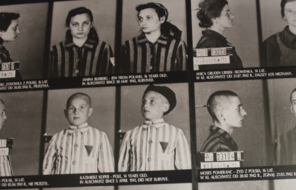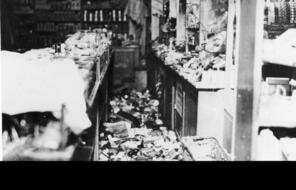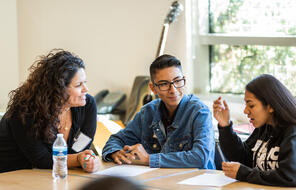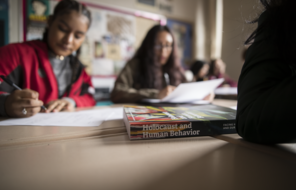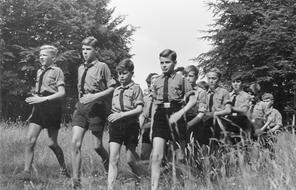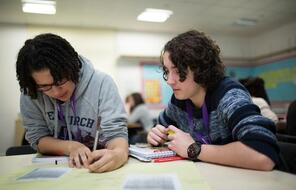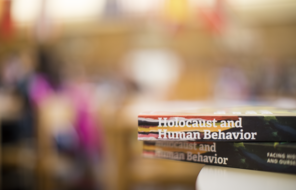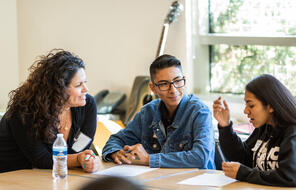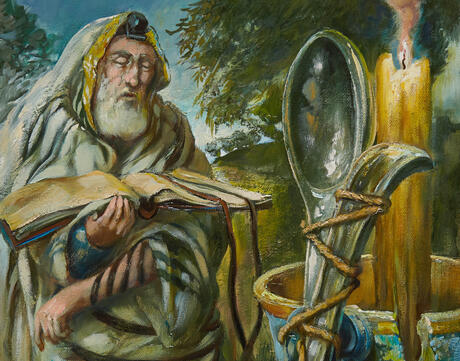
7 Classroom Resources on the Holocaust
International Holocaust Remembrance Day is Thursday, January 27th. This is a day when we remember the 6 million Jews murdered in the Holocaust, their loved ones, and the ways in which this incalculable tragedy has transformed our world. It is also a time for educators to ensure their readiness to integrate instruction on the Holocaust into their annual teaching plans. Research released by the Claims Conference reveals alarming levels of ignorance amongst millennials and generation Z regarding the Holocaust, as well as profoundly harmful notions of Jewish culpability fueled by antisemitic hatred. Teachers have an essential role to play in disrupting these twin evils of ignorance and hatred, and Facing History materials are here to help educators invite students into this learning in middle and high school classrooms.
Below are 7 classroom-ready curricular resources that educators can use to teach about the Holocaust:
- Holocaust and Human Behavior
Holocaust and Human Behavior is Facing History’s seminal work reaching millions of students around the world. Originally published over 40 years ago, it has been regularly updated, most recently in 2016, to reflect the latest scholarship on the Holocaust. Holocaust and Human Behavior helps students and teachers make the essential connection between history and themselves. By using the book of readings, primary sources and attending professional development, teachers take students on a journey through profound questions about human behavior. Key resources include our unit Teaching Holocaust and Human Behavior and our accompanying case study.
- Resistance During the Holocaust: An Exploration of the Jewish Partisans
In this unit, we focus on resistance as seen through the lens of the firsthand experiences of Jewish partisans, the women and men who fought in the armies of the Allies and the Soviet Union and in resistance brigades across Eastern Europe. Students will explore partisans’ lives, struggles, motivations, and goals through text- and video-based testimony, poetry, documentary film, and other primary sources.
- Americans and the Holocaust: The Refugee Crisis
Interweaving Facing History’s innovative approach to historical inquiry with groundbreaking new sources from the United States Holocaust Memorial Museum’s special exhibition Americans and the Holocaust, this unit deeply explores the motives, pressures, and fears that shaped Americans’ responses to Nazism and the humanitarian refugee crisis it provoked during the 1930s and 1940s by examining primary sources.
- Teaching Schindler’s List
Schindler’s List tells the story of Oskar Schindler, a war profiteer and member of the Nazi party who saved over 1,100 Jews during World War II. The movie explores the human capacity for monumental evil as well as for extraordinary courage, caring, and compassion. It turns history into an opportunity for moral reflection. As you consider whether to use Schindler’s List with your students, we recommend that you view the film yourself (even if you have seen it before). The film is available online from streaming services, and you can also borrow it from your school or public library.
- Teaching Who Will Write Our History
Creating an archive that was discovered only after the war, the Oyneg Shabes collected diaries, essays, jokes, poems, and songs—anything that would counter Nazi propaganda and help the world understand life in the Warsaw Ghetto from the perspective of its Jewish inhabitants. Facing History’s two lesson plans for Who Will Write Our History helps students be thoughtful, reflective viewers of the film, and guides them to explore the profound courage and resistance of a group of people who seized control of their own narrative even as they faced certain death.
- Interpreting the Works of Samuel Bak
This series uses Samuel Bak's art in order to help students understand the emotional journeys experienced by Holocaust survivors. Professor Lawrence L. Langer, Professor of English Emeritus, Simmons College has contributed several essays to this outline based upon his extensive research into the life and work of Samuel Bak. Readings from Holocaust and Human Behavior are used to support the interpretive activities.
- Universal Declaration of Human Rights
This unit includes a lesson on the origins of the modern human rights movement in the aftermath of the Holocaust, and deepens understanding of the Charter for the United Nations and the Universal Declaration of Human Rights (UDHR). Readings include selections from various ancient legal codes, the United Nations Charter, the Universal Declaration of Human Rights, and Holocaust and Human Behavior.
Facing History & Ourselves invites educators to use Holocaust and Human Behavior in the classroom.
Don't miss out!
- download classroom materials
- view on-demand professional learning
- and more...

